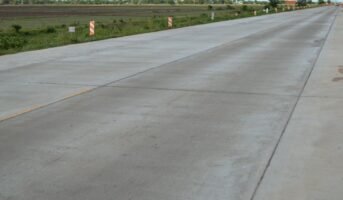Concrete pavement is a concrete layer that remains in contact with traffic directly and used for many purposes. Concrete pavements can be altered in several ways per need. Concrete for pavements should be robust, durable, and cost-efficient. The reason being it is heavily affected by ecological conditions. Concrete pavements are advantageous because they are fit for large point loads, withstand diesel spillage and other materials, and resist high temperatures.
All kinds of concrete pavements are different, each with its advantages:
- Joined unreinforced concrete pavement:
Joined unreinforced concrete pavement comprises batch work of slab layers which are small units connected by tie bars and dowels or joints to help prevent cracks.
- Jointed reinforced concrete pavement:
Jointed reinforced concrete pavements are modified versions of jointed unreinforced concrete pavements. Instead of plain concrete pavement, it is used when there is doubt about the materials. As a result, the thickness of the pavement is thinner, and the joint spacing is more significant compared with the unreinforced concrete pavement.
- Continuously reinforced concrete pavement:
This type of concrete is built as a long slab, and reinforced bars are placed in the middle of the slab.
What is a tie bar?
Tie bars are deformed bars or connectors used for holding rigid slabs in contact to maintain an interlock. They help to decrease transverse cracking and avoid separation and differential deflection of lanes. Tie bars are not for any load transfer. These bars need protection from corrosion. Tie bars are commonly used at edge joints or between longitudinal edge joints and a curb or shoulder.
Applications of tie bars
Applications of tie bars are as follows:
- Tie bars help to decline transverse cracking
- Tie bars are used in the plain jointed concrete pavement to connect two lanes
- Tie bars prevent pavement lanes from deflecting off the slab.
Advantages of tie bars
There are many advantages to the use of Tie Bars. Tie Bars prevent two lanes from separation. It improves the performance of pavement joints substantially. Third, tie Bars make the slabs robust and more durable. Finally, tie bars save the life cycle of concrete.
Alignment and positioning of tie bars
For proper alignment and positioning of tie bars, the depth and locations must be scouted to ensure appropriate placement. First, precision is needed when inserting tie bars to avoid hitting reinforced mats during insertion in fresh concrete. Then, insert tie bars a few inches away from the transverse bar to prevent displacing the carpet.
The size of tie bars depends on the thickness of the concrete surface and the width of the slab. The tie bars diameter varies between 12-16mm and is made up of steel bars. The length of the bar varies between 550mm and 640mm in size.
Tie bars are inserted after one lane is paved by hand or using a tie bar installer. First, the tie bar is installed mid-depth of the slab and bent back until the adjacent lane is prepared and paved. Then, tie bars are inserted at the slabs’ edge with slip-form pavers, which become longitudinal joints.
Tie bars installation problems
There may be problems faced when installing tie bars. The bars may be missing, and equipment may be poorly adjusted. Additionally, the concrete around the tie bars may be poorly consolidated. There may be too stiff a mix caused by mixing delays. The tie bars may also be misplaced.
Utmost care must be undertaken when installing tie bars to prevent movement after placement. One should ensure that the team and equipment do not knock or drag the protruding bars. After installation, plastic sleeves are added to tie bars, which prevents the curing compound from adhering to the bar surface. If any combination sticks, this would negatively impact the bond development of the concrete placed.
Difference between tie bars and dowel bars
Dowel bars are also used in reinforced concrete, similar to tie bars. A dowel bar is a cylindrical metal, wood, or plastic rod that provides a mechanical connection between slabs. The round steel bars help concrete to transfer the load uniformly. Dowel bars are rounded and smooth, whereas tie bars are deformed epoxy-coated steel. The spacing of dowel bars depends on the thickness of the pavement, whereas for tie bars, the spacing depends on the thickness and the width of the slab. Additionally, dowel bars allow for load transferring, which tie bars do not do.
Conclusion
If properly designed and installed, tie bars significantly improve the performance of pavement joints. Although tie bars increase the initial costs, tie bars decrease the overall life cycle cost. Tie bars are designed to handle tensile stress. Tie bars are commonly used as longitudinal joints or between edge joints. Tie bars play a vital role in the construction of roads and pavements. Tie bars help bring stability and reliability. The high price initially paid for installing tie bars eventually helps in the long run and lifespan of the concrete pavement.
FAQs
How are the designs of tie bars made?
Tie bars are generally 15mm, 20mm, 26.5 mm, and 32 mm in diameter and are typically supplied as 6m in length. The length and thickness of the slab determine the correct spacing and placement of tie bars. The larger the diameter of tie bar steel, the bigger the distance allowed between the tie bars.
Is bending of tie bars allowed?
Earlier, it used to be a common practice to bend protruding tie bars until their requirement for the next lane. This practice no longer uses the steel tie bars and reduces lifespan.
What is tie bar spacing?
The tie bar spacing entirely depends on the thickness and width of the concrete slab.
What is an essential point when installing tie bars?
Tie bars are not loaded transferring devices. It just serves to tie two slabs together. Thus, tie bars must be deformed, hooked, and anchored into concrete to function correctly.
What is the main benefit of a tie bar for concrete pavements?
Tie bars increase the lifecycle of concrete by reducing cracks that may occur. Though initial costs are high, tie bars lead to less stress and low deflections upon concrete, leading to good joint performance.
Housing News Desk is the news desk of leading online real estate portal, Housing.com. Housing News Desk focuses on a variety of topics such as real estate laws, taxes, current news, property trends, home loans, rentals, décor, green homes, home improvement, etc. The main objective of the news desk, is to cover the real estate sector from the perspective of providing information that is useful to the end-user.
Facebook: https://www.facebook.com/housing.com/
Twitter: https://twitter.com/Housing
Email: [email protected]











